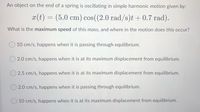Question

Transcribed Image Text:An object on the end of a spring is oscillating in simple harmonic motion given by:
x(t)
= (5.0 cm) cos((2.0 rad/s)t + 0.7 rad).
What is the maximum speed of this mass, and where in the motion does this occur?
10 cm/s, happens when it is passing through equilibrium.
2.0 cm/s, happens when it is at its maximum displacement from equilibrium.
O 2.5 cm/s, happens when it is at its maximum displacement from equilibrium.
O 2.0 cm/s, happens when it is passing through equilibrium.
10 cm/s, happens when it is at its maximum displacement from equilibrium.
Expert Solution
This question has been solved!
Explore an expertly crafted, step-by-step solution for a thorough understanding of key concepts.
This is a popular solution
Trending nowThis is a popular solution!
Step by stepSolved in 2 steps

Knowledge Booster
Similar questions
- A 2.36 kg ball is attached to an unknown spring and allowed to oscillate. The figure (Figure 1) shows a graph of the ball's position as a function of time t. Figure x (cm) 3.0 2.0 1.0 -1.0 -2.0 -3.0 1 of 1 A 1.0 0.50 t(s) What is the amplitude? Express your answer in centimeters to one decialm place. A = Submit Part E VE ΑΣΦ k= Answer ? What is the force constant of the spring? Express your answer in newtons per meter to three significant figures. ΨΕ ΑΣΦ cm ? N/marrow_forwardA spring with spring constant 15.0 N/m hangs from the ceiling. A ball is suspended from the spring and allowed to come to rest. It is then pulled down 6.00 cm and released. If the ball makes 30 oscillations in 20.0 s, what are its (a) mass and (b) maximum speed?arrow_forwardA spring Is suspended vertically from a celling. When a 2.80-kg mass is attached to the bottom of the spring, Its equilibrlum length Increases by 4.00 cm. If the mass Is further pulled down by 5.00 cm from its new equilibrlum length and released, what is the frequency of the simple harmonic motion?arrow_forward
- The graph shows the x-displacement as a function of time for a particular object undergoing simple harmonic motion. This function can be described by the following formula:x(t) = Acos(ωt+φ)where x and A are measured in meters, t is measured in seconds, ω is measured in 1/s and φ is measured in radians. A=2.90m, T=4.00s, ω=1.57 1/s, f=2.50*10^-1 Hz Determine the phase constant i.e. find the smallest positive value for φ.arrow_forwardAstronauts in space cannot weigh themselves by standing on a bathroom scale. Instead, they determine their mass by oscillating on a large spring. Suppose an astronaut attaches one end of a large spring to her belt and the other end to a hook on the wall of the space capsule. A fellow astronaut then pulls her away from the wall and releases her. The spring's length as a function of time is shown in the figure (Figure 1). Figure L (m) W 1.4 1.2- 1.0 0.8 0.6 0.4 0.2 0.0 T 3 1 of 1 -t (s) What is her mass if the spring constant is 270 N/m ? Express your answer with the appropriate units. m = 62 kg Submit Part B Correct V = What is her speed when the spring's length is 0.70 m ? Express your answer with the appropriate units. 0.81 Previous Answers Submit Provido Foodbook ΠΑ m sec Previous Answers Request Answer ?arrow_forwardA09. The displacement of a body moving with simple harmonic motion is given by the equation y = A sin(2t + ½T) After one-quarter of a period has elapsed since t= 0, which of the following statements is сorrect? A) Half the total energy of the body is kinetic energy and half is potential energy. B) The kinetic energy is a maximum. C) The potential energy is a maximum. D) The total energy is a negative maximum. E) Both kinetic and potential energies are maxima.arrow_forward
- Astronauts on a distant planet set up a simple pendulum of length 1.20 m. The pendulum executes simple harmonic motion and makes 100 complete oscillations in 280 s. What is the magnitude of the acceleration due to gravity on this planet?arrow_forwardAssume you have a spring with an elastic constant of 85 N/m, and want it to oscillate once every 0.45 seconds. What mass would you need to attach to the spring?arrow_forward
arrow_back_ios
arrow_forward_ios